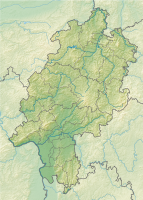Rallenteich from Eppertshausen
|
Rallenteich from Eppertshausen
|
||
|
Rallenteich of Eppertshausen (2020) |
||
| location | Eppertshausen , Darmstadt-Dieburg district , Hesse | |
| surface | 12 ha | |
| WDPA ID | 82362 | |
| Geographical location | 49 ° 57 ' N , 8 ° 49' E | |
|
|
||
| Setup date | October 7, 1976 | |
The Rallenteich of Eppertshausen is a nature reserve in the Eppertshausen district in the Darmstadt-Dieburg district , southern Hesse . The nature reserve was designated in 1976 and covers an area of around 12 hectares.
location
The protected area is about 1.3 kilometers west of Eppertshausen in the forest. The former clay pit area consists of the Rallenteich, a small still body of water and the surrounding forest and meadow area. In the north the landscape protection area "Landkreis Offenbach" borders, in the south there is a larger pond of a younger clay pit.
history
From around the 15th century until 1947/48, clay was dug on the site, with each potter family dismantling their own "barrel vault". When the land was abandoned, the surface layers collapsed, the pits filled with water, and swamp and aquatic plants populated the areas. The holes were partially filled with sticky sand from the clay pit adjacent to the south. The mining area was also temporarily under discussion as a garbage dump. When the biological importance of the biotopes was recognized, efforts were made from 1970 to protect the area. The designation as a nature reserve was made by ordinance of October 7, 1976.
description
The central part of the protected area consists of a water surface partly overgrown with reeds, which at the edges merges into broken forest in places. There are large sedge stocks in the south. In the wetlands, common sedge , cypergrass sedge , iris iris , buttercup buttercup and common frog spoon are found. A acidic oak forest borders to the west and northwest, which is interspersed with shallow, water-filled mining pans. Bear moss , peat moss and liverwort grow in swampy areas . In the north, pines and alien spruces dominate a sand dump.
Due to the small-scale structures, the area is extremely rich in animal species. So breed here about 40 species of birds, including Goldcrest , little grebe , teal , teal , snipe , Water Rail , Spotted Crake , turtledove , middle spotted woodpecker , lesser spotted woodpecker , wryneck and red-backed shrike .
The nature reserve is home to ten species of amphibians: common toad , common frog , agile frog , pond frog , marsh frog , tree frog , salamander , newt , alpine newt and crested newt . There have been tunnels under Kreisstrasse 180 Eppertshausen - Messel since 2012 to make the amphibian migration to the Rallenteich from February to April safer. The number of migratory amphibians is subject to annual fluctuations, but has fallen sharply overall in recent years: in 1999, 4,792 animals were counted, in 2019 only (extrapolated) 410 animals were recorded.
Individual evidence
- ↑ a b Ordinance on the nature reserve "Rallenteich von Eppertshausen" in the district of Dieburg. (PDF) State Gazette for the State of Hesse 44/1976, p. 1969, No. 1428., October 7, 1976, accessed on July 7, 2020 .
- ↑ Nature reserves in Darmstadt-Dieburg. Natural History Institute Langstadt, accessed on October 25, 2019 .
- ↑ Map of the nature reserve. natureg.hessen.de, accessed on July 7, 2020 .
- ↑ a b c d 0tto Diehl & Wolfgang Heimer: "Rallenteich von Eppertshausen" - a clay pit becomes a nature reserve. Vogel und Umwelt Volume 1, pp. 197-201. 1981.
- ↑ Six tunnels ensure survival of amphibians. op-online.de, March 29, 2013, accessed on October 25, 2019 .
- ↑ Amphibians cross the K180 safely. op-online.de, April 9, 2016, accessed on July 7, 2020 .
- ↑ Amphibian Protection, Amphibian Monitoring 2019 at Kreisstraße 180. Odenwaldklub Eppertshausen eV, accessed on October 25, 2019 .




